Types of Magnolia Tree Varieties – Stunning & Popular
With Saucer magnolia being the most common one, magnolias are found in more than 200 different varieties.
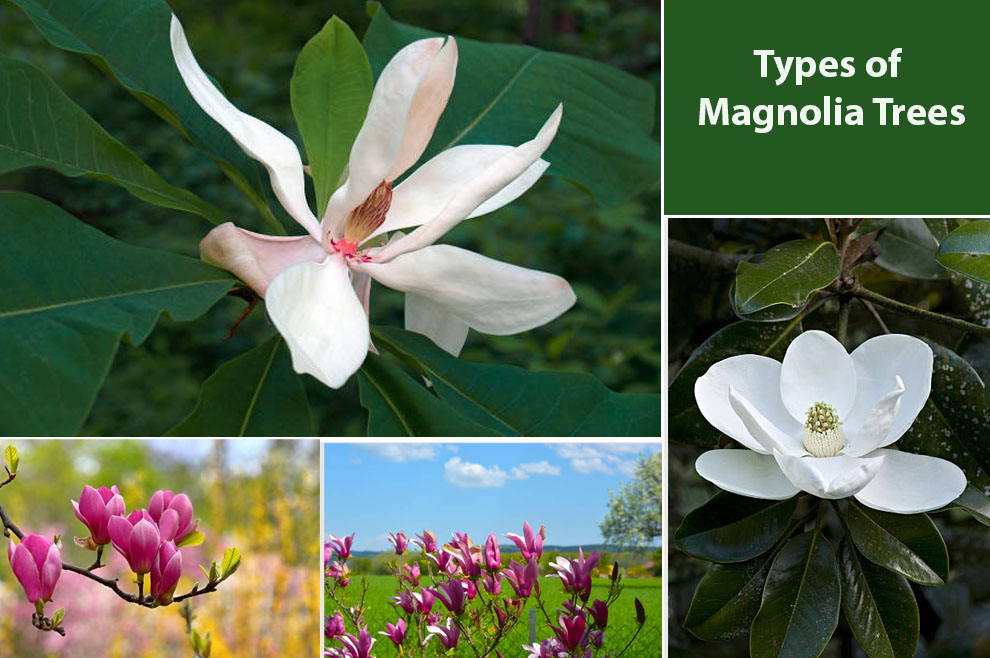
Beautiful flowering plants, magnolias are a classic shrub and tree, often referred to as the symbol of the South. You can find magnolia trees in various sizes, bloom shapes, and colors. Native to North America and Southeast Asia, Magnolias are not restricted to any particular region today.
Considering the hybrid and cultivars, there are more than two hundred different types of magnolia trees. They are a remarkably diverse plant genus, comprising species that thrive in colder climates and usually bloom between April to January, depending on the chosen variety.
Flowering magnolias are fragrant. You will see its flowers as pink or white blooms, appearing in early spring, much before the leaves show.
Magnolias can be deciduous or evergreen, depending on their geography. While some magnolia trees are upright, massive in size, others are multi-stemmed shrubby plants.
Magnolias grow best in full sun. But, they can also alter their growing habits to some extent depending on the environment and the climate they are grown. Though they are typically not fast-growing, your patience will be rewarded with pretty amazing blooms.
Beautiful and Fragrant Magnolia Tree Varieties
- Bigleaf Magnolia
- Sweetbay Magnolia
- Lily Magnolia
- Chinese Magnolia
- Saucer Magnolia
- Southern (little gem) Magnolia
- Star Magnolia
- Kobus Magnolia
- Anise Magnolia
- Jane Magnolia
- Cucumber Magnolia
Different Kinds Of Magnolia Trees With Lovely Blooms
Before you pick a Magnolia tree for your home, here are a few things you must know about their growing habits, distinct features, and magnolia care.
1. Bigleaf Magnolia
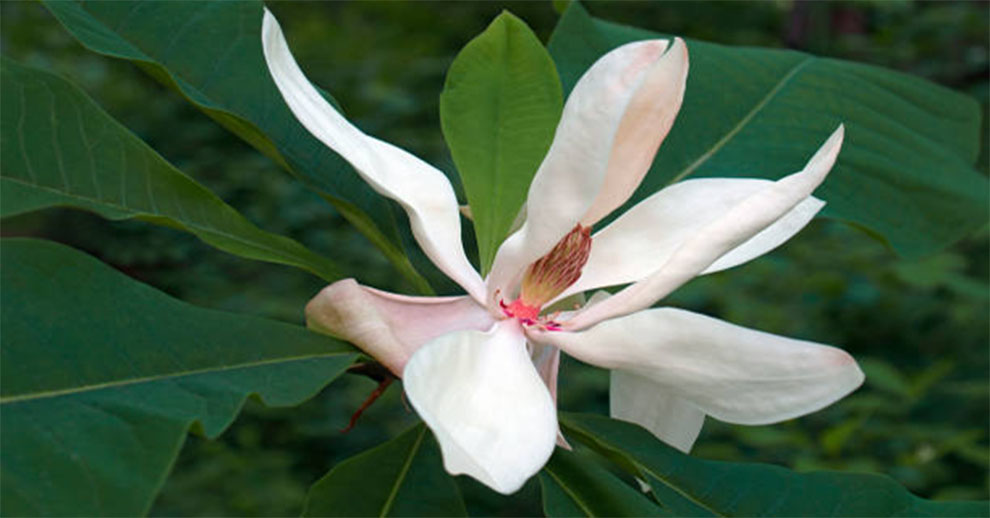
| Bloom color | Creamy white with purple petal bases |
| Size | 30 to 40 feet, occasionally to 60 feet |
| Soil | Well-drained loam or sand with slightly acidic to alkaline pH |
| Sun | Full sun or part shade |
| Water | Moderate water, but they do not like waterlogged soil or long periods of drought. |
This Magnolia variety lives up to its name and yields about twelve to thirty-two inches long leaves. Like the other different types of magnolia trees, even this one is a deciduous plant that is evergreen in the warmer zones.
Its flowers usually show in May and are about ten inches across. Native to South Eastern US and Mexico, they are drought tolerant but vulnerable to wind and ice damage.
Botanically called the Magnolia macrophylla, they grow best in USDA hardiness zones five through eight. Its large leaves decompose slowly but undergo damage, resulting in a litter problem. Sadly, it is not the most appealing in the small garden setting, but it can be an excellent specimen tree or a good addition in larger yards.
2. Sweetbay Magnolia
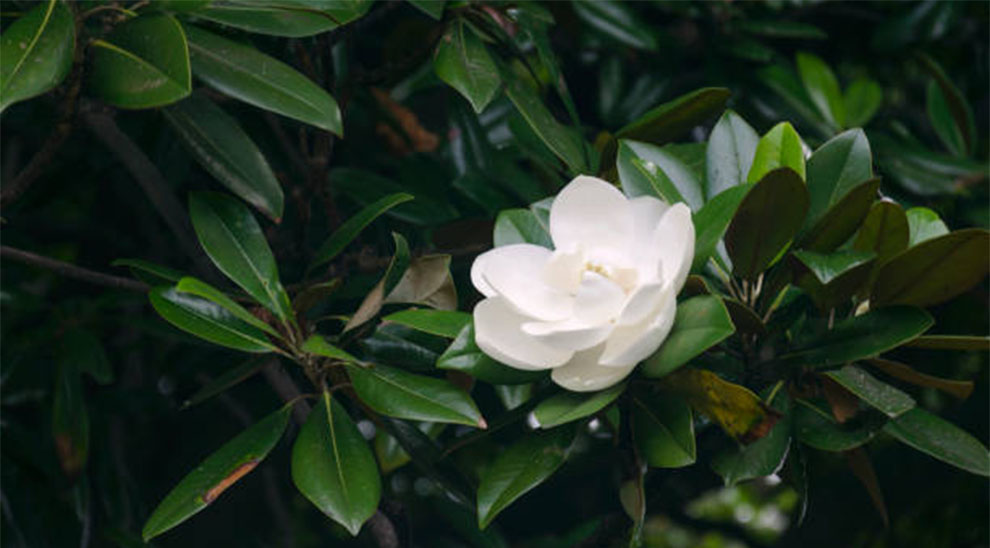
| Bloom color | Waxy white flowers |
| Size | 10 to 35 feet |
| Soil | Boggy or clay soils |
| Sun | Full sun to part shade |
| Water | Can tolerate moist soils and even bouts of standing water |
Regionally called the Swamp Magnolia, Beaver tree, or Laurel Magnolia, the Sweetbay Magnolia is a deciduous shrubby plant with several stems. If grown in the winter zones, it is an upright tree that remains evergreen.
Its flowers show between mid-summer and early autumn. Native to Eastern America, its vibrant, green leaves have silver undersides. The plant thrives in USDA hardiness zones five through ten. It is one of the pest-resistant varieties.
Magnolia virginiana, often known as the Sweetbay Magnolia is a pest resistant variety. It is a stunning shade tree that produces masses of creamy white flowers. Typically, these flowers start to show up in late spring or early summer.
3. Lily Magnolia
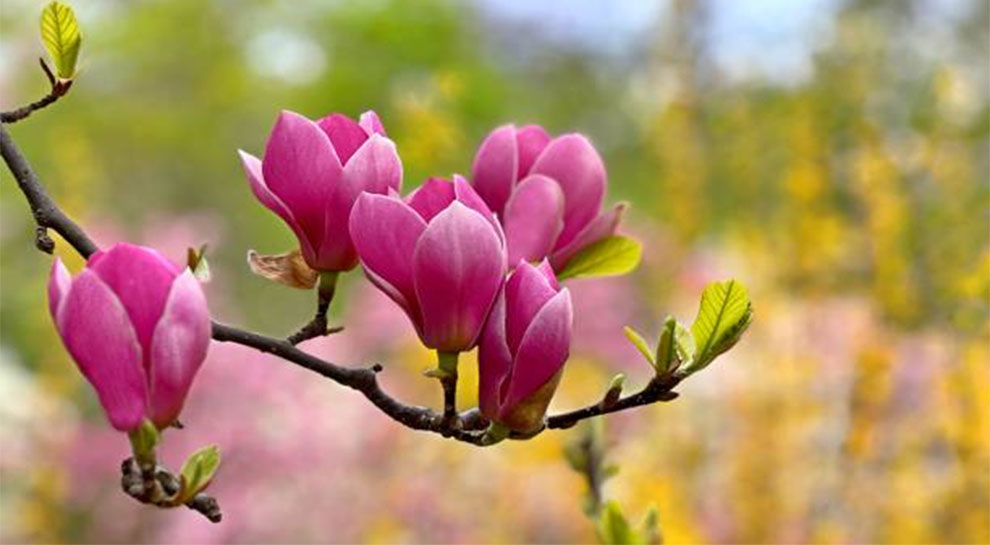
| Bloom color | Pink or Purple, but sometimes burgundy, lavender, gold, and copper |
| Size | Eight to twelve feet |
| Soil | Moist, well-drained soil with acidic to neutral pH |
| Sun | Full sun to part shade |
| Water | Moderate |
It is one of the smaller magnolia tree varieties that does not go larger than a bush or a shrub. They get their name from their flower colors that resemble lilies. Before the leaves open, the shrub yields a massive flush of flowers in early spring.
Once the flowers fall off, its dark green elliptical leaves show, which become golden in the fall. Native to Southwest China, the plant thrives in USDA zones seven through ten and is a parent of the Saucer Magnolia. Its roots are sensitive. Hence, transplantation can be tricky.
4. Chinese Magnolia
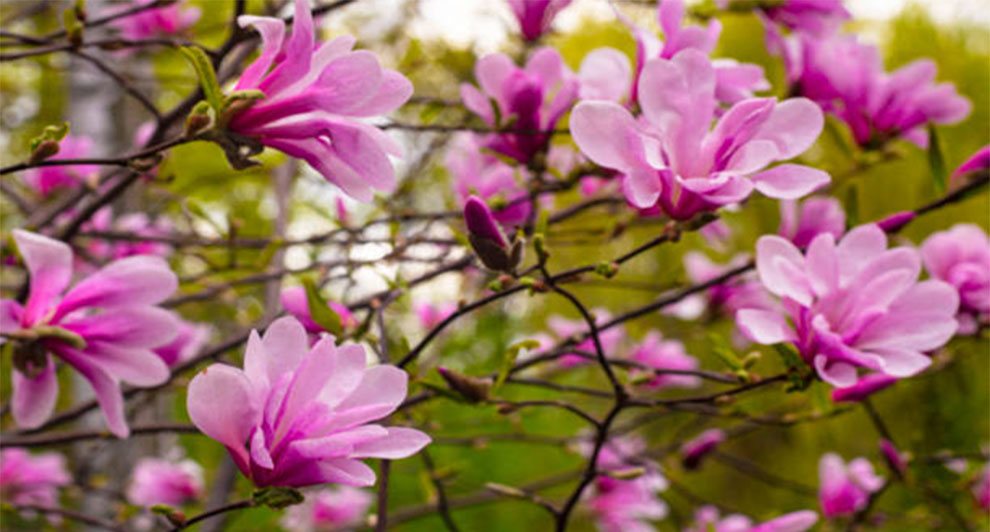
| Bloom color | White and pink |
| Size | 10 to 12 feet high with 8 to 10 feet spread |
| Soil | Well-drained soil |
| Sun | Full to partial sun |
| Water | Moderate |
Also called the Lilliputian, the Chinese Magnolia is a beautifully spreading and popular variety that blooms early to mid-spring. It is one of the tiniest saucer magnolia trees, and its flowers are fragrant and gorgeous that appear on the bare branches in early spring. When the flowers drop, the leaves appear. The plant thrives best in USDA hardiness zones six through nine and is an attraction for butterflies and birds. Chinese Magnolia is best cultivated as a deciduous, compact flowering shrub.
5. Saucer Magnolia
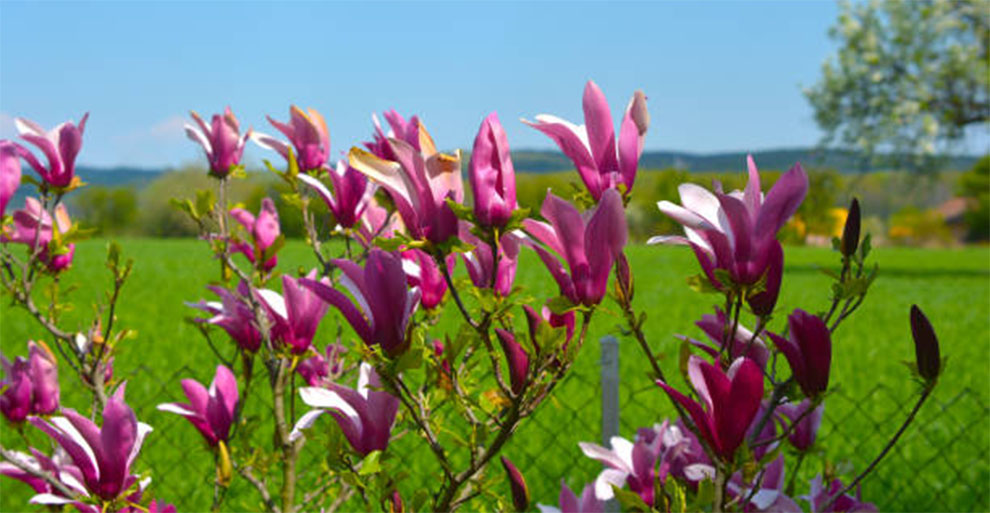
| Bloom color | Pink and white |
| Size | 20’–30′ tall with a 25′ spread |
| Soil | Moist, deep, acid soil |
| Sun | Full sun to part shade |
| Water | Moderate |
These hybrid magnolia tree varieties belong to the Chinese Magnolia family and are created by crossing the Yulan and Lily Magnolia. It is a low-branched, small tree with large saucer-type flowers or a large shrub with several stems, and its flowers show in early spring before the leaves appear.
They are medium to fast growing and have good pollution toleration. Hence, they are an excellent choice for medium or sidewalk plantings. They thrive in USDA zones four through nine. It is one of the most prevalently grown Magnolia in the United States.
6. Southern (Little gem) Magnolia
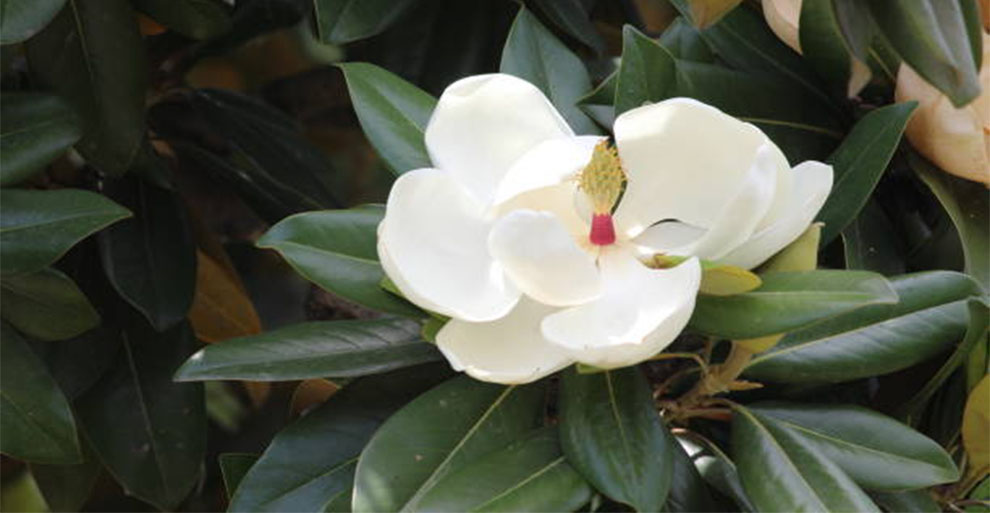
| Bloom color | Large, creamy white with six petals |
| Size | 60-80 feet |
| Soil | Acidic, loamy, moist, sandy, well-drained, and clay soils |
| Sun | Full sun and partial shade |
| Water | It has a moderate drought tolerance and can also stand some flooding. |
Often referred to by its floral name, Magnolia grandiflora, it is another of the most prevalent kinds of magnolia trees, especially in the South. So, when you hear people talking about Magnolia, they are probably referring to this specie. The plant has fragrant flowers that amplify the beauty of this broad-leafed evergreen plant between early summer and late spring. Southern Magnolia thrives in USDA hardiness zones six through ten.
We do not suggest this variety for regions that see cold winters. However, in some areas, they can survive in zone six too. However, they demand good wind protection if growing in the Northern Regions.
7. Star Magnolia
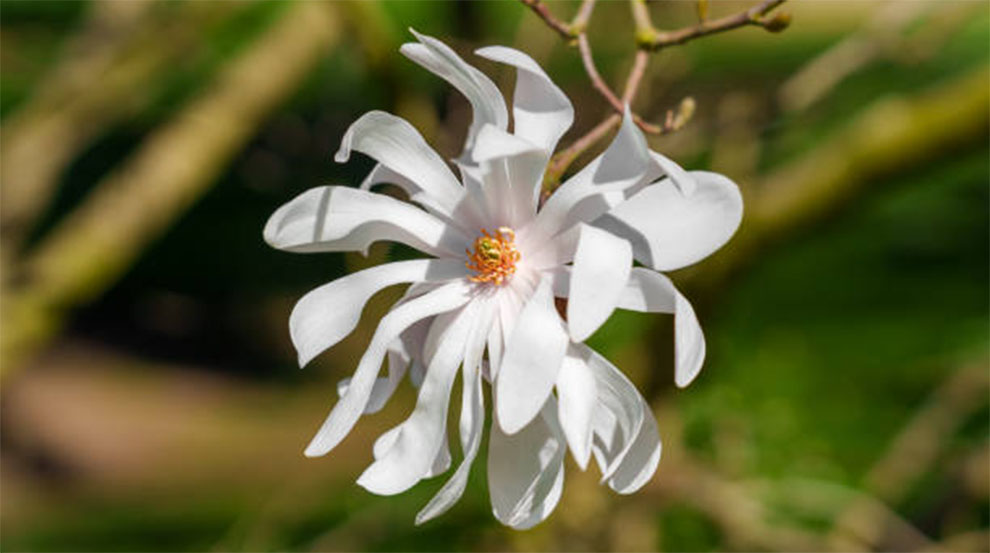
| Bloom color | White flowers |
| Size | 15 to 20 feet with 10 to 15 feet spread |
| Soil | Acidic, loamy, moist, sandy, well-drained, and clay soils |
| Sun | Full Sun to Part Shade |
| Water | It has a moderate drought tolerance and can also stand some flooding. |
Native to Japan, Star Magnolia or Magnolia Stellata has beautiful flowers that show in March. They are about four-inch in diameter and are star-shaped. It is a hardy deciduous tree, and the flowers show before the leaves like in the majority of magnolia tree species. Its leaves are on the smaller side and have a tapered shape.
The tree does not grow well in pollution and soil extremes. When you plant this tree, ensure that you keep it away from direct Southern exposure because this kind of sun exposure can result in Magnolia blooming too early.
Eventually, they may freeze and die before the spring season starts. The plant grows best in USDA hardiness zones four through eight. You can use it as a foundation planting or specimen plant.
8. Kobus Magnolia
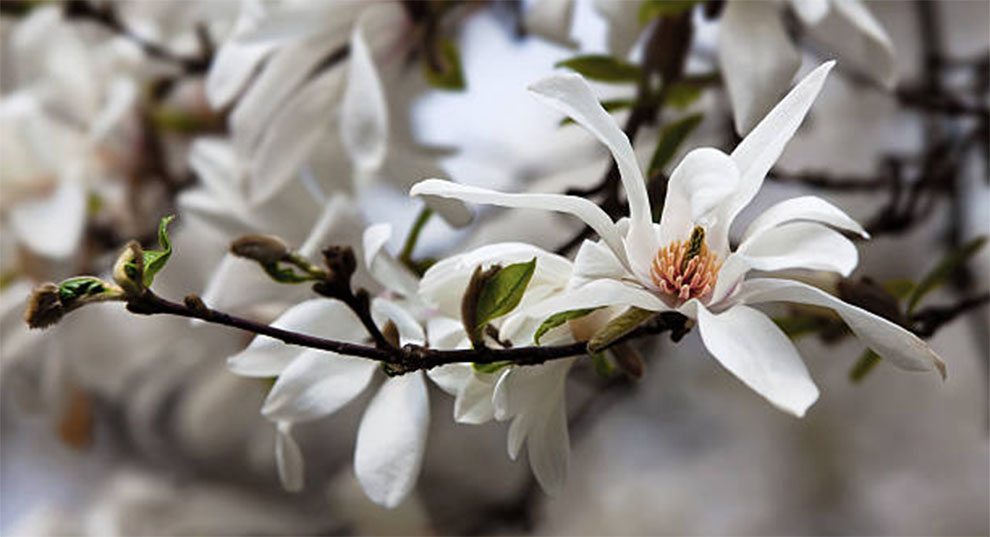
| Bloom color | Cream-colored and tinged with pink |
| Size | 25-30’ with an almost similar spread, but occasionally 75 feet with very old trees |
| Soil | Moist, organically rich, well-drained soils with acidic to slightly alkaline pH |
| Sun | Full sun to part shade |
| Water | Moderate, ensuring the soil is neither too wet nor too dry. |
Kobus Magnolia are attractive magnolia tree species that look even more explicit during the winters, courtesy of their rounded shape. Also called the Japanese magnolia or northern Japanese magnolia, the Kobus seek open fields and areas where the plant can grow unobstructed.
They are prominent in America, but they are not native. The Kobus Magnolia came from Southern China and is native to the forests in Japan. It has a slow growth rate but grows as a large shrub or a small-medium deciduous tree.
Their beautiful and delicate flowers show faster than most other Magnolia varieties and open as early as March. The plant can take almost three decades to mature, but they bloom before that.
Their flowers are fragrant, and the plant turns yellow and golden in the fall before finally falling off the tree in winter. They are planted as specimen trees and thrive in USDA zones five through eight.
Related: Planting Japanese magnolia trees|Why is my magnolia tree dying?
9. Anise Magnolia
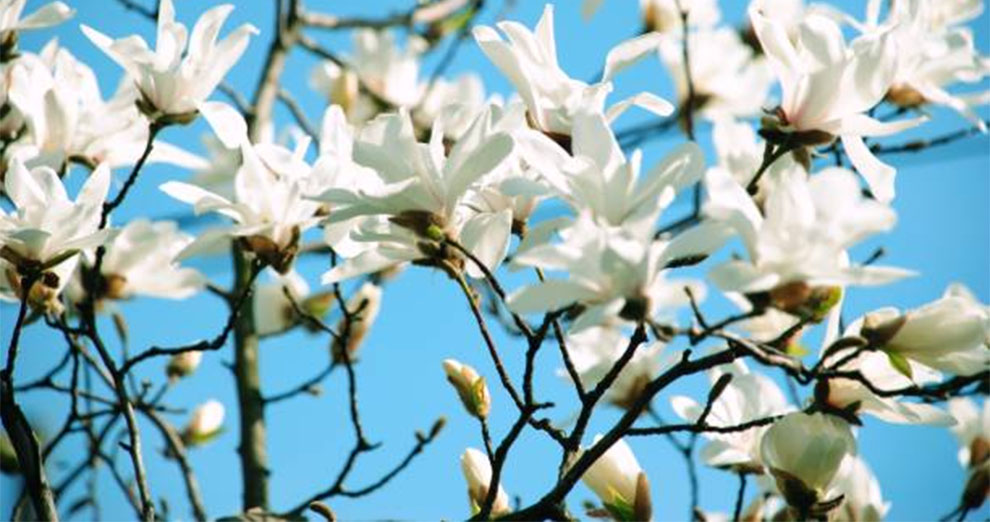
| Bloom color | White with curling edges |
| Size | 50 feet |
| Soil | Part shade |
| Sun | Well-drained, acidic soil |
| Water | Moderate |
Native to Japan, Anise Magnolia is one of the popular types of magnolia trees with a pyramidal, mature form. Their shape develops from the narrower upright form in their youth. Its blooms show in early spring and have a lemon-like scent.
Like the other varieties, even the Anise flowers show before the foliage that is willow-like and narrow. The plant has deciduous leaves, which have the same scent as the bark when scraped or broken. You can prune the magnolia in summer when the plant has leaves.
10. Jane Magnolia

| Bloom color | Pink, white, and purple flowers |
| Size | Eight to twelve feet |
| Soil | Acidic, loamy, moist, rich, sandy, silty loam and well-drained soils |
| Sun | Full sun |
| Water | Sensitive to drought and flooding |
These are beautiful, small types of magnolia trees or large deciduous shrubs that produce flowers in early spring. Typically, the plant takes at least four to five years to flower. So, if the blooms do not appear, do not give up on the plant.
Native to southwest China, the plant is cultivated across Japan and China and is a pick excellent for hardiness zones four through eight. Once the fall arrives, the trees look ragged. You can use them for borders or accents.
11. Cucumber Magnolia

| Bloom color | Greenish, tulip-shaped flowers |
| Size | 60 to 80 feet |
| Soil | Moist, rich, and well-drained loams |
| Sun | Full sun to part shade |
| Water | Intolerant to either dry or wet extremes |
These magnolia tree varieties are so-called because their fruits look like vegetables. Native to the Appalachian regions of the U.S., southern Ontario, Cucumber Magnolia is the most cold-hardy, classic Southern magnolia and has relatively less showy bloom but large growth habit and giant glossy leaves.
Though the flowers have a fragrance, it is nothing like the larger varieties. You can use it as a specimen tree for colder regions or a shade tree, provided you are ok with the mess that large leaves usually create. The plant thrives in USDA zones three through eight.
Related: Magnolia tree growth rate
Frequently Asked Questions
Ques 1. How do I identify my magnolia tree?
Ans. You can identify the magnolias with their large, aromatic flowers. Individual Magnolia species have distinctive blooms. You can also recognize the Magnolia trees via their elongated, long leaves and shiny, smooth surface.
Ques 2. What is the hardiest magnolia tree?
Ans. Star magnolias are one of the hardiest varieties of magnolia trees.
Ques 3. What is the most fragrant magnolia tree?
Ans. Champaca Magnolia is one of the most fragrant magnolia tree species.
Ques 4. Do all magnolia trees bloom?
Ans. Magnolias have a long lifespan with beautiful blooms. They can be deciduous or evergreen, but all of them have striking, large blooms with petal-like segments.
Ques 5. What magnolia trees stay small?
Ans. Little Gem Magnolia always stays small.
